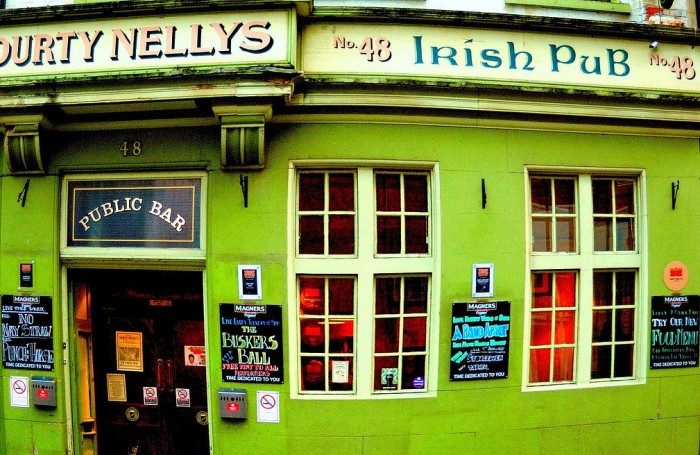
This coming week will see another celebration of St. Patrick’s Day, the 17 March festival honouring the Romano-British missionary who brought Christianity to the Emerald Isle. In practice, however, St. Patrick’s Day serves as a convenient excuse for sloughing off the winter blues by donning kelly green and ‘Kiss Me, I’m Irish’ t-shirts, listening to jigs, attending parades, and—most importantly—drinking to excess (Lenten restrictions on alcohol consumption are lifted for a day in many Catholic dioceses for purposes of ‘observance’). Once confined to Ireland, celebrations have spread via the Irish diaspora, becoming popular in Great Britain, North America, the Antipodes, Argentina, and farther afield. The Irish pub tends to be the primary locus of St. Patrick’s Day revelry. Once a forlorn redoubt for marginalised Hibernian immigrants living in low-income districts, Irish pubs are now big business, often being situated in city centres commanding a well-heeled clientele. From Copenhagen to Dubai to Ulan Bator, the Irish pub has made its mark. Backed by the marketing power of Diageo, the world’s largest producer of spirits, St. Patrick’s Day has been turned into a genuinely international holiday. As more and more people around the world flock to Irish pubs for a bit of craic (fun), and compounded by the rapidly expanding popularity of beer and whiskey consumption worldwide, a highly circumscribed aspect of ‘Irishness’ is being folded into the fabric of our creolized global culture.
With the internationalisation of the Irish pub, as well as its unflagging popularity across the United States, Canada, Australia, and the UK, it is interesting to note what I refer to as the ‘performative geopolitics’ that typically characterise the space of these drinking establishments. Upon entering the cloistered, bric-a-brac laden space that is the typical Irish pub, any first-time visitor is likely to be surprised at how (geo)political the environment is. Common to nearly all Irish pubs is an obsession with the Irish flag; however, it is not only the familiar green, white, and orange of the Republic of Eire that one sees; the more militant green-and-gold Erin go Bragh (‘Ireland forever’) flag of the nineteenth-century Irish nationalists will also adorn the walls. Maps abound in most of these watering holes as well, performing geopolitics through a carefully framed visualisation of space. Historic maps showing the Irish Free State often sit side-by-side with wishful maps adorned with the slogan ‘26+6=1’, an espousal of the desire of many Irish to see the Republic absorb the counties of Northern Ireland (a goal that for many has been delayed but not deferred by the 1998 Good Friday Agreement). In terms of the aural ambiance, any stop at a pub worth its salt will result in the visitor hearing one or two ‘rebel songs’, i.e., ditties extoling the fight for Irish independence or the campaign against British occupation of the northern counties. Even one’s choice of drink bleeds political identity, from the Black-and-Tan (a porter-and-pale ale beer cocktail that invokes the Royal Irish Constabulary Reserve Force) to the Irish Car Bomb (a mixture of Guinness, Bailey’s Irish Cream and Jameson’s whiskey that refers to the Provisional IRA’s favoured tool of terror).
Most explicit is the visual-textual hagiography of the founders of the Republic, from the revolutionary Michael Collins to the statesman Éamon de Valera. These demigods of Irish political mythology loom large in many an Irish pub (sometimes joined by the leader of Sinn Féin Gerry Adams), looking down on the patrons as the nip their Bushmills or quaff a pint of Murphy’s stout. In more high-minded taverns, these visages are situated alongside the Isle’s literary luminaries like William Butler Yeats, James Joyce, and Oscar Wilde, perhaps even sharing the space with Irish-American presidents, including John F. Kennedy, Ronald Reagan, and Bill Clinton (all strong supporters of Ireland even as they maintained the U.S.’s ‘special relationship’ with Great Britain). In the more politically acute pubs, one might even be confronted with pictures of slain fighters from the Easter Rising (1916), the 1919 text of the Forógra na Saoirse (‘Declaration of a Free State’), or the preamble to the Constitution of the Irish Free State (1922).
Unlike the English pub, which is less prevalent but nonetheless popular around the world, the Irish saloon exudes a clarion geopolitical message (and one which does not accurately represent increasingly multicultural Eire’s place within the European Union alongside its old enemy, the United Kingdom). Whereas the English pub roots itself in a lost imperium and distant Victorian mores, the Irish pub boldly defines geopolitical codes and visions, which it expects its denizens to adopt (at least while imbibing within its walls). While this geopolitical aesthetic may seem innocuous or banal at first blush, it is nonetheless important if it accomplishes the task of influencing the worldview of the patron. So on this St. Paddy’s Day, take a look around at the walls and ceilings of the pub as you nurse your pint of stout. No doubt, you will see that the Irish War of Independence, while won, is not yet done. It is still being fought every day through a performative aesthetics, the likes of which any propagandist would be proud.
Further Reading on E-International Relations
- Geopolitics and John Dee
- Plotting the Future of Popular Geopolitics: An Introduction
- The Future of Popular Geopolitics: Zombie Evolution and the Return to the Social
- Everyone is Talking About It, but What is Geopolitics?
- From Order to Chaos: What Made Geopolitics Return?
- Geopolitics and the British Empire: Halford Mackinder’s Liberal Imperialism
